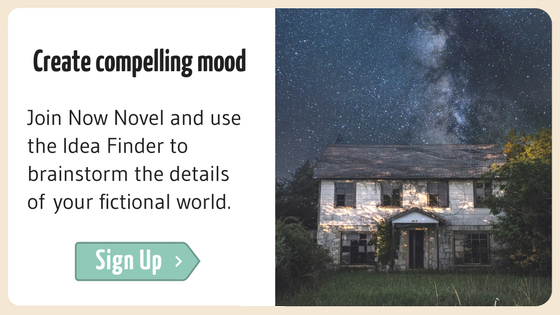Tone and mood are two powerful elements of writing that affect how readers feel. Tone tells us a lot about characters - a protagonist whose tone is mostly sarcastic, for example, might seem jaded. Mood is closely tied to place. The atmosphere of a story setting, how characters feel about it, affects the mood. Read useful examples of tone and mood from fiction and tips for improving your own:
Examples of tone: 'The Yellow Wallpaper' by Charlotte Perkins Gilman
'The Yellow Wallpaper' (1892) by the 19th Century American author, Charlotte Perkins Gilman, offers strong examples of tone. In the story, the narrator's tone is initially cheerful. She describes the 'colonial mansion' she and her husband John share for the summer:
'A colonial mansion, a hereditary estate, I would say a haunted house, and reach the height of romantic felicity - but that would be asking too much of fate! Still I would proudly declare that there is something queer about it.'
As the story progresses, however, the narrator's optimistic tone changes. We see that John is controlling towards her, and she becomes increasingly obsessed with the idea that there is a woman imprisoned behind the 'strangest yellow' wallpaper. She starts to imagine it has a terrible odor:
'Now we have had a week of fog and rain, and whether the windows are open or not, the smell is here.
It creeps all over the house.
I find it hovering in the dining-room, skulking in the parlor, hiding in the hall, lying in wait for me on the stairs.'
The narrator's tone becomes fearful. The verbs she uses contribute to the anxious tone and fearful mood (the smell 'creeps' and 'lies in wait', suggesting sneakiness and malevolence).
Shifts in tone throughout the story create an increasingly dark tone and mood. This matches the plot events, as the woman's identity blurs and the viewpoint narrator becomes the creeping woman living behind the yellow wallpaper.

Examples of mood: 'The Fall of the House of Usher' by Edgar Allan Poe
Edgar Allan Poe's famous short story 'The Fall of the House of Usher' (1839) is a classic example of American Gothic fiction. It's full of great examples of mood in writing. Poe is a master of conjuring a gloomy, eerie atmosphere. Consider his opening:
'During the whole of a dull, dark, and soundless day in the autumn of the year, when the clouds hung oppressively low in the heavens, I had been passing alone, on horseback, through a singularly dreary tract of country, and at length found myself, as the shades of the evening drew on, within view of the melancholy House of Usher.'
Mood in writing is 'the way a group of people feel about something; the atmosphere in a place or among a group of people' (OED). The way the atmosphere of a place affects feeling is clear in Poe's opening. Poe chooses adjectives such as 'dull,' 'dark' and 'soundless' to create an oppressive, stagnant atmosphere. He makes this mood explicit when he uses the adverb 'oppressively' to make the clouds seem weighted down; too close.
Gothic and horror writing rely on these dark undertones to create unsettling effects, and mood and atmosphere are pivotal.
The mood of Poe's story gets darker still as the narrator describes the house where his ailing childhood friend Roderick Usher and his sister Madeleine live:
'Its principal feature seemed to be that of an excessive antiquity. The discoloration of ages had been great. Minute fungi overspread the whole exterior, hanging in a fine tangled web-work from the eaves [...]'
The mood of neglect and dank darkness continues. The faded quality of the house and the 'tangled webwork' of fungus growing over it both add to the mood of abandoned neglect. Poe chooses his adjectives well, creating a consistent tone of gloom, which prepares us for the paranormal , morbid goings on at the house. The mood of the story contributes an eerie feeling that supports its bizarre events (later, the narrator helps his friend entomb his sister, which in turn leads to his friend's dramatic death).

How can you use tone and mood in your writing to enrich your novel?
5 tips for creating effective tone and mood
1. Choose verbs and adverbs that add tone and mood
The words you use to describe your characters' actions colour how we read them, contributing to tone and mood. In 'The Yellow Wallpaper', for example, the verbs Charlotte Perkins Gilman uses, as her narrator's sanity dissolves, become increasingly ominous.
Her narrator describes the smell of the wallpaper as 'creeping' and 'lying in wait'. These verbs of ambush and stealth effectively create an anxious tone, showing the narrator's increasing unease.
When describing characters' actions:
- Use strong, standalone descriptive verbs rather than verbs with adverbs where possible. To imply stealth, 'she crept' is clearer and more visual than 'she walked sneakily'
- Think about the tone you want to achieve in a scene and list verbs you could use (for example, if you want a violent tone in a conflict scene, write down options such as 'crushed', 'shoved', 'bellowed', 'slammed', etc.)
2. Use adjectives that create strong mood in descriptions
In 'The Fall of the House of Usher', Poe's adjective choices consistently build the mood. The sombre, dark tone of his story fits its eerie, paranormal subject matter. Adjectives suggesting decay and entrapment are everywhere, from the way Poe describes the fungi covering the house as 'tangled' to his description of the 'dreary' countryside. He also uses the word 'oppressively' to describe how low the clouds in his landscape hang, making even the clouds seem to have some darker purpose.
To bolster mood with description:
- Use related adjectives and imagery to create and sustain mood. Poe's description pairs imagery of damp with imagery of overgrowth, from the word 'dank' (meaning 'unpleasant damp and cold') to the cobweb-like description of the fungus covering the house
- Favour emotive describing words: Even when adjectives are synonyms, one is often emotively much stronger. Compare 'small' and 'minute' (minute literally means 'chopped small', from its Latin root). Describing a character who lives in a 'minute' rather than 'small' house truly creates a sense of how poky and uncomfortable the place is
3. Change tone and mood to highlight plot and character development
In a story like 'The Yellow Wallpaper', we see how effectively changes of tone and mood can underscore plot development. The narrator's changing tone reflects her worsening psychological state. Think about ways you can change the way a character speaks or narrates to underscore their shifting experience.
Take a character who is nervous before a first date, for example. They might narrate in shorter, more scattered phrases as the encounter approaches, suggesting their racing thoughts.
4. Exploit a mismatch between tone and mood for dramatic or comical effect
In some scenarios, creating a mismatch between tone and mood is a useful technique. In a horror story about a haunted house, for example, you could first create a creepy tone describing the house from an omniscient narrator's viewpoint, then contrast this with a lighter tone when a group of joking kids entering the house on a dare (this is a cliche of the haunted house trope). This mismatch is effective because the prior mood creates expectations in us as readers. We want to shout at the kids, 'Get out!'
This approach to tone and mood - contrasting the two - is an effective technique for showing characters who are oblivious to impending situations. It isn't only effective for creepy situations. Consider a romantic example:
Character Ted is about to propose to Charlotte, and has chosen a romantic setting. Charlotte has no inkling of his intention.
You might describe and evoke the romantic setting Ted has painstakingly created. Yet you could also contrast this romantic mood with dialogue that is the opposite of romantic. Perhaps Charlotte is grumpy and beligerent, in an argumentative frame of mind due to a bad day at work.
This scenario and the contrast between the clearly romantic mood of the setting (and our knowledge of Ted's plans) and the conversation could make the proposal scene comical, bordering on farce. The contrast between tone and mood also creates dramatic tension. We empathize as poor Ted strives to create the romantic interaction he imagined.
5. Create and keep a cheat sheet of good examples of tone and mood
When you're reading, if an author writes a phrase or passage that creates an effective tone or mood, write it down. Keep a book of extracts that demonstrate different types of tone and mood (for example 'gloomy', 'cheerful', 'romantic' and so forth). The simple act of consciously copying out what works in other authors' work (and jotting down why) will help you to create better tone and mood yourself.
Ready to brainstorm details for the mood of your novel? Join Now Novel now and use our prompts to flesh out a blueprint for your book.










I do keep a list as you describe in number 5 of this article and find it very helpful in my writing, my editing, and my teaching. Excellent article!
Mahala Church - Over 8 years ago
Thank you so much, Mahala. A good example can be so instructive.
Bridget At Now Novel - Over 8 years ago